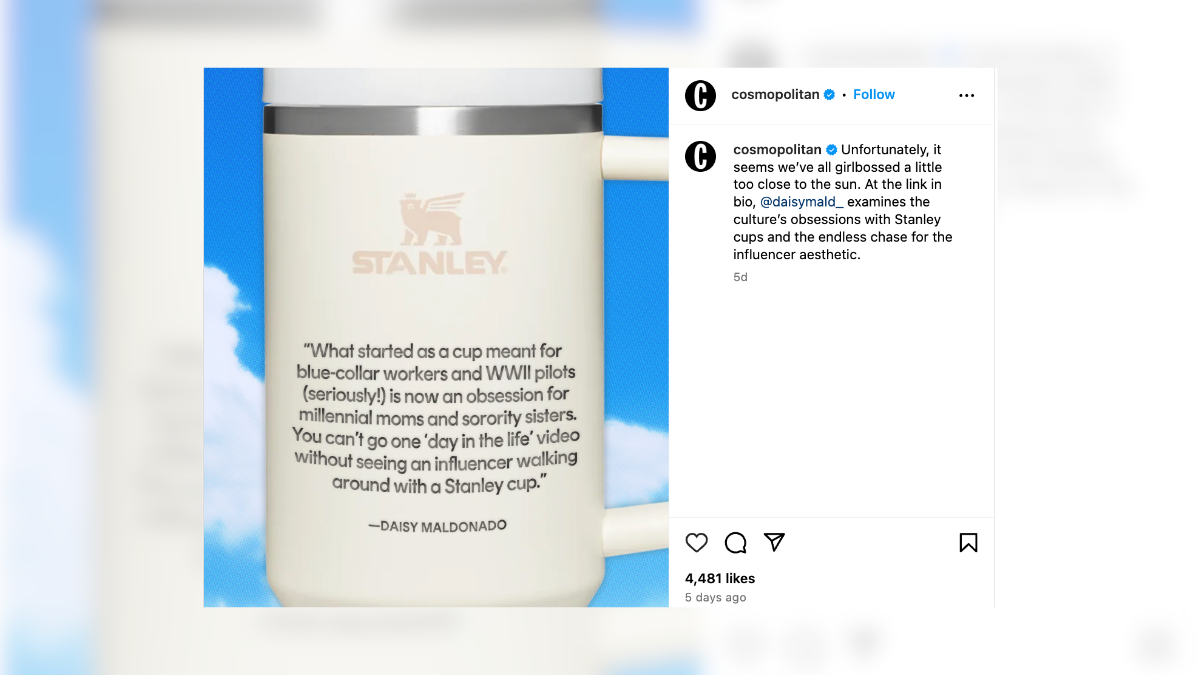Invented in 1913, Stanley cups were said to have been an "indestructible thermos for heavy bomber pilots" during World War II. At least, that's according to a 2023 post (archive) on Reddit that described the invention of the popular drinking vessel.
The above claim was later popularized in a Jan. 19, 2024, opinion post published by Cosmopolitan (archive) discussing Stanley cups and the "endless chase for the influencer aesthetic." In the piece, author Daisy Maldonado wrote: "What started as a cup meant for *checks notes* blue-collar workers and WWII pilots (seriously!) is now an obsession for millennial moms and sorority sisters." This quote was later shared on Instagram on Feb. 24, 2024 (archive):
The story posted amid the craze whereby the "thermos for tough guys" had become the "TikTok obsession of millennials," with people camping out to buy the hottest color.
The original Stanely Cup patent was filed by inventor William Stanley in 1912, two years before the First World War and decades before World War II. There was no mention of pilots or war in the original 1912 Stanley patent. World War I began in 1914 and World War II started in 1939 – years after the patent was filed.
We have therefore rated this claim as "False."
Snopes found the original patent filed on Aug. 5, 1912, and issued on Sept. 9, 1913, which described "certain new and useful improvements in heat-insulated receptacle." Nowhere in the patent language were mentions of "pilot" or "war." (Note that Snopes corrected some spelling errors below that resulted from formatting issues.)
My invention relates to heat insulating barriers and more particularly to the insulation of receptacles having an inner shell surrounded by an outer shell with a vacuous space there between and commonly known as vacuum bottles etc. My invention, however, may be applied to milk cans and many other devices and arrangements.
The common vacuum receptacle has its shells or walls constructed of glass and accordingly, such receptacles are likely liable to breakage and cannot withstand hard usage. Moreover, it is found that a very high degree of exhaustion must be maintained in the vacuous space to get sufficient heat insulation to make devices practicable for ordinary uses. Furthermore, because such receptacles are made of glass they are limited in size.
All of this said, it's been reported that World War II servicemen, primarily pilots, did indeed use the bottles and products. According to a blog (archive) published on the Stanley website:
It was 1913 when William Stanley invented the all-steel, double-wall vacuum bottle and stuck his name on it. Rumor has it, that he wanted his coffee hot all day while he was working, and was inspired to apply some of his theories learned while developing transformers. As it turns out, necessity really is the mother of invention …
Today, Stanley's Built For Life™ promise means that your grandad's thermos that supported pilots in World War II could very well get set beside that brand spankin' new Classic Vacuum Insulated Bottle you picked up for your weekend camping trip.
Snopes has also looked into whether Stanley tumblers contain an unsafe amount of lead.

